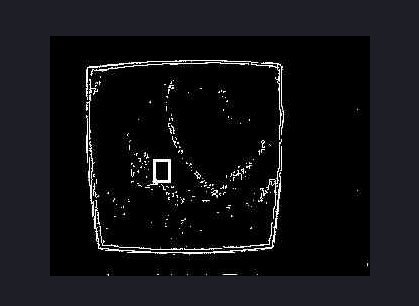字体显示不出来,只有一个框框
-
# 在图像上使用morph函数来进行边缘检测。 # 然后在进行阈值和核滤波 # 最后进行特征点检测 import sensor, image, time,lcd #设置核函数滤波,核内每个数值值域为[-128,127],核需为列表或元组 kernel_size = 1 # kernel width = (size*2)+1, kernel height = (size*2)+1 kernel = [-1, -1, -1,\ -1, +8, -1,\ -1, -1, -1] # 这个一个高通滤波器。见这里有更多的kernel # http://www.fmwconcepts.com/imagemagick/digital_image_filtering.pdf thresholds = [(100, 255)] # grayscale thresholds设置阈值 sensor.reset() # 初始化 sensor. sensor.set_pixformat(sensor.GRAYSCALE) # or sensor.RGB565 sensor.set_framesize(sensor.QVGA) # or sensor.QVGA (or others) sensor.skip_frames(10) # 让新的设置生效 lcd.init() clock = time.clock() # 追踪FPS # 在OV7725 sensor上, 边缘检测可以通过设置sharpness/edge寄存器来增强。 # 注意:这个会edge detection can be enhanced # significantly by setting the sharpness/edge registers. # Note: This will be implemented as a function later. if (sensor.get_id() == sensor.OV7725): sensor.__write_reg(0xAC, 0xDF) #在address(int)向相机寄存器中写入value(int) sensor.__write_reg(0x8F, 0xFF) #在address(int)上读取摄像头数据表 kpts1 = image.load_descriptor("/desc.orb") while(True): clock.tick() # Track elapsed milliseconds between snapshots(). img = sensor.snapshot() # Take a picture and return the image. img.morph(kernel_size, kernel) #morph(size, kernel, mul=Auto, add=0),morph变换,mul根据图像对比度 #进行调整,mul使图像每个像素乘mul;add根据明暗度调整,使得每个像素值加上add值。 #如果不设置则不对morph变换后的图像进行处理。 img.binary(thresholds) #利用binary函数对图像进行分割 # Erode pixels with less than 2 neighbors using a 3x3 image kernel img.erode(1, threshold = 2) #侵蚀函数erode(size, threshold=Auto),去除边缘相邻处多余的点。threshold #用来设置去除相邻点的个数,threshold数值越大,被侵蚀掉的边缘点越多,边缘旁边 #白色杂点少;数值越小,被侵蚀掉的边缘点越少,边缘旁边的白色杂点越多。 kpts2 = img.find_keypoints(max_keypoints=150, threshold=10, normalized=True) #如果检测到特征物体 if (kpts2): #匹配当前找到的特征和最初的目标特征的相似度 match = image.match_descriptor(kpts1, kpts2, threshold=85) #image.match_descriptor(descritor0, descriptor1, threshold=70, filter_outliers=False)。 #本函数返回kptmatch对象。 #threshold阈值设置匹配的准确度,用来过滤掉有歧义的匹配。这个值越小,准确度越高。阈值范围0~100,默认70 #filter_outliers默认关闭。 #match.count()是kpt1和kpt2的匹配的近似特征点数目。 #如果大于10,证明两个特征相似,匹配成功。 if (match.count()>25): # If we have at least n "good matches" # Draw bounding rectangle and cross. #在匹配到的目标特征中心画十字和矩形框。 img.draw_rectangle(match.rect()) img.draw_cross(match.cx(), match.cy(), size=10) res=img.draw_string(100,100,'合格',color=255,scale=5,x_spacing=2) lcd.display(res) else: res=img.draw_string(100,120,'不合格',color=255,scale=5,x_spacing=2) lcd.display(res) #match.theta()是匹配到的特征物体相对目标物体的旋转角度。 print(kpts2, "matched:%d dt:%d"%(match.count(), match.theta())) #不建议draw_keypoints画出特征角点。 # NOTE: uncomment if you want to draw the keypoints #img.draw_keypoints(kpts2, size=KEYPOINTS_SIZE, matched=True) print(clock.fps())
-
OpenMV的LCD不能显示中文。
解决办法:用英文字母。
-
。。。。好的吧。谢谢!
’